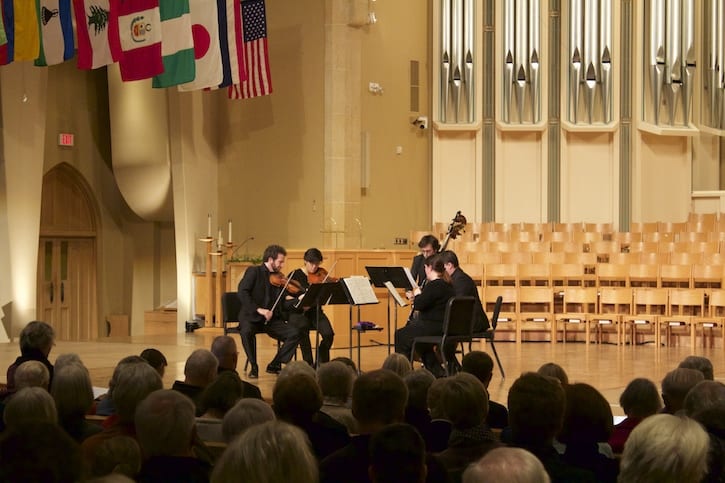
The St. Paul Chamber Orchestra, met with great acclaim in Minnesota and beyond for virtuosic performance in a variety of styles, recently stopped by Boe Chapel to share an eclectic array of chamber music. Patrons filing into the hall were offered a bit of a sampler for the musical feast they were about to encounter from the musicians warming up on and off stage. Eventually this ceased, and two of the performers stepped up to address the crowd and explain the context of the performance and repertoire. They talked about the historical context of the pieces they were to play, going into a fair amount of detail about the character of Joachim Raff, who composed one of the pieces, mentioning that any inquirers could make their way to raff.org for more information.
The first piece was a work by Sergei Prokofiev for a woodwind and string-based quintet. Composed in the mid-1920s, the piece was meant to reflect the darker aspects of circus life for a touring German-based ballet troupe. The performance was marked with a sort of questionable beauty, where darkness in aching rhythms and uneasy harmonies was offset by clear, pure melodic lines. The performers moved in tandem with the music and one another, filling the echoey chapel to the brim despite the limited orchestration.
The next piece was composed by the aforementioned Raff, who history has somewhat obscured. A sinfonietta solely for winds, strings were cast aside for this interlude. Lacking the slightly sinister tinge of the last work, this performance was jubilant and uplifting. Written to entertain at general festivities, the performance was not resigned to simplicity, and instead highlighted the creativity that underlies the piece, making it interesting while adhering to conventions. Immediately after the performance, many patrons spent the intermission speaking about this piece, a few remarking that they were surprised they had never heard of the composer before.
The last portion of the performance was the largest, incorporating many more performers to play “Serenade for Winds” by Antonin Dvorak. Written to be a pleasing piece of music where movements aren’t strongly affiliated, Dvorak’s marked melodic creativity shone through in the expressive stylings of the chamber ensemble. The music built slowly and surely, ultimately culminating in a grand gesture of triumph, to which the performers took their bows and the audience’s standing ovation.
After the performance’s conclusion the crowd was atwitter with excitement and satisfaction, with attendees remarking upon the masterful playing and fulfilling experience.
The eagerness and appreciation for this performance of music that general perception may consider antiquated indicates a positive situation for St. Olaf. Perhaps performances like this from the St. Paul Chamber Orchestra can shift public views about music that is often considered “dead.”
campbe1@stolaf.edu
Graphic Credit: BECCA REMPEL/MANITOU MESSENGER

